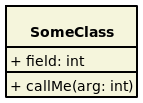10 KiB
Style Sheets
Since Gaphor 2.0, diagrams can have a different look by means of style sheets. Style sheets use the Cascading Style Sheets (CSS) syntax. CSS is used to describe the presentation of a document written in a markup language, and is most commonly used with HTML for web pages.
On the W3C CSS home page, CSS is described as:
Cascading Style Sheets (CSS) is a simple mechanism for adding style (e.g., fonts, colors, spacing) to Web documents.
Its application goes well beyond web documents, though. Gaphor uses CSS to provide style elements to items in diagrams. CSS allows us, users of Gaphor, to change the visual appearance of our diagrams. Color and line styles can be changed to make it easier to read the diagrams.
Since we're dealing with a diagram, and not a HTML document, some CSS features have been left out.
The style is part of the model, so everyone working on a model will have the same style.
Here is a simple example of how to change the background color of a class:
class {
background-color: beige;
}
Or change the color of a component, only when it's nested in a node:
node component {
background-color: skyblue;
}
The diagram itself is also expressed as a CSS node. It's pretty easy to define a "dark" style:
diagram {
background-color: black;
}
* {
color: white;
text-color: white;
}
Here you already see the first custom attribute: text-color. This property
allows you to control the color of the text drawn in an item. color is used
for the lines (strokes) that make the layout of a diagram item.
Supported selectors
Since we are dealing with diagrams and models, we do not need all the features of CSS. Below you'll find a summary of all CSS features supported by Gaphor.
============================= ============================
``*`` All items on the diagram, including the diagram itself.
``node component`` Any component item which is a descendant of a node.
``node > component`` A component item which is a child of a node.
``generaliation[subject]`` A generalization item with a subject present.
``class[name=Foo]`` A class with name "Foo".
``diagram[name^=draft]`` A diagram with a name starting with "draft".
``diagram[name$=draft]`` A diagram with a name ends with "draft".
``diagram[name*=draft]`` A diagram with a name containing the text "draft".
``diagram[name~=draft item]`` A diagram with a name of "draft" or "item".
``diagram[name|=draft]`` A diagram with a name is "draft" or starts with "draft-".
``\*:focus`` The focused item. Other pseudo classes are:
- ``:active`` selected items
- ``:hover`` for the item under the mouse
- ``:drop`` if an item is dragged and can be dropped on this item
``node:empty`` A node containing no child nodes in the diagram.
``:root`` An item is at the top level of the diagram.
This is only applicable for the diagram
``:has()`` The item contains any of the provided selectors.
E.g. ``node:has(component)``: a node containing a component item.
``:is()`` Match any of the provided selectors.
E.g. ``:is(node, subsystem) > component``: a node or subsystem.
``:not()`` Negate the selector.
E.g. ``:not([subject])``: Any item that has no "subject".
============================= ============================
- The official specification of CSS3 attribute selectors.
- Gaphor provides the
|=attribute selector for the sake of completeness. It's probably not very useful in this context, though. - Please note that Gaphor CSS does not support IDs for diagram items, so the
CSS syntax for IDs (
#some-id) is not used. Also, class syntax (.some-class) is not supported currently.
Style properties
Gaphor supports a subset of CSS properties and some Gaphor specific properties.
The style sheet interpreter is relatively straight forward. All
widths, heights, and sizes are measured in pixels. You can't use complex style
declarations, like the font property in HTML/CSS which can contain font
family, size, weight.
Colors
======================= =======================================
``background-color`` Examples:
``background-color: azure;``
``background-color: rgb(255, 255, 255);``
``background-color: hsl(130, 95%, 10%);``
``color`` Color used for lines
``text-color`` Color for text
``opacity`` Color opacity factor (``0.0`` - ``1.0``),
applied to all colors
======================= =======================================
- A color can be any CSS3 color code,
as described in the CSS documentation. Gaphor supports all color notations:
rgb(),rgba(),hsl(),hsla(), Hex code (#ffffff) and color names.
Text and fonts
======================= =======================================
``font-family`` A single font name (e.g. ``sans``, ``serif``, ``courier``)
``font-size`` An absolute size (e.g. ``14``) or a size value (e.g. ``small``)
``font-style`` Either ``normal`` or ``italic``
``font-weight`` Either ``normal`` or ``bold``
``text-align`` Either ``left``, ``center``, ``right``
``text-decoration`` Either ``none`` or ``underline``
``vertical-align`` Vertical alignment for text
Either ``top``, ``middle`` or ``bottom``
``vertical-spacing`` Set vertical spacing for icon-like items (actors, start state)
Example: ``vertical-spacing: 4``
======================= =======================================
font-familycan be only one font name, not a list of (fallback) names, as is used for HTML.font-sizecan be a number or CSS absolute-size values. Only the valuesx-small,small,medium,largeandx-largeare supported.
Drawing and spacing
======================= =======================================
``border-radius`` Radius for rectangles: ``border-radius: 4``
``dash-style`` Style for dashed lines: ``dash-style: 7 5``
``line-style`` Either ``normal`` or ``sloppy [factor]``
``line-width`` Set the width for lines: ``line-width: 2``
``min-height`` Set minimal height for an item: ``min-height: 50``
``min-width`` Set minimal width for an item: ``min-width: 100``
``padding`` CSS style padding (top, right, bottom, left)
Example: ``padding: 3 4``
======================= =======================================
paddingis defined by integers in the range of 1 to 4. No unit (px, pt, em) needs to be used. All values are in pixel distance.dash-styleis a list of numbers (line, gap, line, gap, ...)line-styleonly has an effect when defined on adiagram. A sloppiness factor can be provided in the range of -2 to 2.
Diagram styles
Only a few properties can be defined on a diagram, namely background-color
and line-style. You define the diagram style separately from the diagram item
styles. That way it's possible to set the background color for diagrams
specifically. The line style can be the normal straight lines, or a more
playful "sloppy" style. For the sloppy style an optional wobliness factor can
be provided to set the level of line wobbliness. 0.5 is default, 0.0 is a
straight line. The value should be between -2.0 and 2.0. Values between 0.0 and
0.5 make for a subtle effect.
Ideas
Here are some ideas that go just beyond changing a color or a font. With the following examples we dig in to Gaphor's model structure to reveal more information to the users.
To create your own expression you may want to use the Console (Tools -> Console, in the Hamburger menu). Drop us a line on Gitter and we would be happy to help you.
The drafts package
All diagrams in the package "Drafts" should be drawn using sloppy lines:
diagram[owner.name=drafts] {
line-style: sloppy 0.3;
}
diagram[name=draft] * {
font-family: Purisa; /* Or use some other font that's installed on your system */
}
Unconnected relationships
All items on a diagram that are not backed by a model element, should be drawn in a dark red color. This can be used to spot not-so-well connected relationships, such as Generalization, Implementation, and Dependency. These items will only be backed by a model element once you connect both line ends. This rule will exclude simple elements, like lines and boxes, which will never have a backing model element.
:not([subject], :is(line, box, ellipse, commentline)) {
color: firebrick;
}
Navigable associations
An example of how to apply a style to a navigable association is to color an association blue if neither of the ends are navigable. This color could act as a validation rule for a model where at least one end of each association should be navigable. This is actually the case for the model file used to create Gaphor's data model.
association:not([memberEnd.navigability*=true]) {
color: blue;
}





